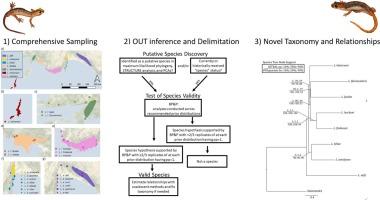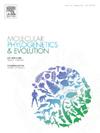Phylogenomics reveal species limits and inter-relationships in the narrow-range endemic lycian salamanders
IF 3.6
1区 生物学
Q2 BIOCHEMISTRY & MOLECULAR BIOLOGY
引用次数: 0
Abstract
Salamanders of the genus Lyciasalamandra are represented by as many as 20 narrow-range endemic taxa inhabiting the Mediterranean coast of Turkey and a handful of Aegean Islands. Despite recent molecular phylogenetic studies, the genus is rife with uncertainty about the number of contained species and their phylogenetic relationships, both of which can interfere with needed conservation actions. To test species limits and infer interrelationships we generated as many as 113,176 RAD loci containing 229,427 single nucleotide polymorphisms (SNPs), for 110 specimens of Lyciasalamandra representing 19 of the 20 described taxa. Through a conservative species delimitation approach, we found support for eight species in the genus which broadly agree with currently described species-level diversity. We then use multiple coalescent-based species tree methods to resolve relationships in this relatively old, synchronous species radiation. We recommend synonymization of the largely over-split subspecific taxa, and the elevation of L. luschani finikensis to full species status as L. finikensis. Our hope is that this revised taxonomic framework provides a stable foundation for conservation management in these fragile, microendemic taxa.

系统发生组学揭示了窄程地方性里氏蝾螈的物种限制和相互关系。
Lyciasalamandra 属蝾螈有多达 20 个狭窄范围的特有类群,栖息于土耳其地中海沿岸和少数爱琴海岛屿。尽管最近进行了分子系统发育研究,但该属所含物种的数量及其系统发育关系仍充满不确定性,这两者都会干扰所需的保护行动。为了测试物种限制和推断相互关系,我们为 110 个 Lyciasalamandra 标本生成了多达 113,176 个 RAD 位点,包含 229,427 个单核苷酸多态性(SNPs),这些标本代表了 20 个已描述类群中的 19 个。通过保守的物种划分方法,我们发现该属有 8 个物种,与目前描述的物种多样性基本一致。然后,我们使用多种基于聚合的物种树方法来解决这一相对古老的同步物种辐射中的关系问题。我们建议对大部分过度分裂的亚种类群进行异名化,并将 L. luschani finikensis 提升为正式种,即 L. finikensis。我们希望修订后的分类框架能为这些脆弱的小地方类群的保护管理提供一个稳定的基础。
本文章由计算机程序翻译,如有差异,请以英文原文为准。
求助全文
约1分钟内获得全文
求助全文
来源期刊
CiteScore
7.50
自引率
7.30%
发文量
249
审稿时长
7.5 months
期刊介绍:
Molecular Phylogenetics and Evolution is dedicated to bringing Darwin''s dream within grasp - to "have fairly true genealogical trees of each great kingdom of Nature." The journal provides a forum for molecular studies that advance our understanding of phylogeny and evolution, further the development of phylogenetically more accurate taxonomic classifications, and ultimately bring a unified classification for all the ramifying lines of life. Phylogeographic studies will be considered for publication if they offer EXCEPTIONAL theoretical or empirical advances.

 求助内容:
求助内容: 应助结果提醒方式:
应助结果提醒方式:


